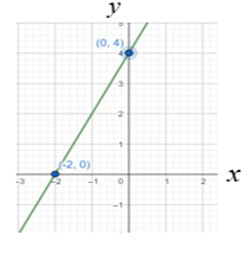
Concept explainers
To graph : the function by plotting ordered pairs
Explanation of Solution
Given information :
The function is
Graph :
Find the intercepts
Let
Since
Let
Since
Therefore, the graph is obtained as

Interpretation : From the above graph it can be observed that that ordered pairs are
Chapter 9 Solutions
Glencoe Math Accelerated, Student Edition
Additional Math Textbook Solutions
Basic Business Statistics, Student Value Edition
Introductory Statistics
University Calculus: Early Transcendentals (4th Edition)
Using and Understanding Mathematics: A Quantitative Reasoning Approach (6th Edition)
A Problem Solving Approach To Mathematics For Elementary School Teachers (13th Edition)
Elementary Statistics (13th Edition)
- 7. Consider the following parametric curve: x = sint, y = 2 cost, for 0 ≤t≤ a) Eliminate the parameter to find a rectangular equation for the curve. b) Use the parametric equations to find the slope of the tangent line when t = c) Use the parametric equations to set up an integral to represent the arc length of the curve. You do not need to evaluate the integral.arrow_forward10. Consider the polar equation r = sin² (2) a) Find the (rectangular) equation of the tangent line when 0 => b) Set up an integral to represent the arc length of the curve for 0arrow_forward2. Which of the following differential equations has the direction field shown? Explain your answer and support it with calculations. Full credit will not be given without sufficient justification. a) y' = x + 2y 31 12 b) y' = y - ¹× c) y' = (x + 1)(y+1) / 1 +-2 1-311 Harrow_forward8. Graph the polar equation r = 4 cos 30. Show work to fully justify your graph. 2 2 2 2arrow_forward9. Consider the cardioid r = 1 + cos 0. a) Set up an integral to represent the area inside the cardioid. b) Evaluate the integral you set up in part (a).arrow_forwardFree Response Question-1 Calculator NOT Allowed 2 D 2 E F 4 Graph off G t -S g(x) <-4 -2 2 G 1 4 8 2 0 3 -1 5 3 7 -2 8 -12 B The function f is given by the graph above left. Selected values of the function g are given in the table above right. The function f is modeled by a polynomial of degree n with leading coefficient a. There are no zeros beyond the interval shown on the graph. Answer the following questions regarding these functions. A. What is the degree, n of the polynomial based on the graph? Give a reason for your conclusion. B. For the function f(x) = ax" what can you determine about the sign of a? How do you know? C. On what interval(s) is the rate of change of f (x) positive and decreasing? Explain how you know. D. The function g is modeled by a polynomial of degree m. Determine the minimum value of m. Justify your answer. E Find the average rate of change of g on the interval 1≤ x ≤ 3.arrow_forwardIn the following exercises, evaluate each definite integral using the Fundamental Theorem of Calculus, Part 2. 170. 171. 2 -1 3 ། - dx (2² – 3x) d L₁ (2² + (x² + 3x - ! - 5) dxarrow_forwardA region is bounded by y = 0, y = x³, and x = 1. Find the x coordinate of the center of mass. Round off to two decimal places. Remember if A is the area of the region then 1 x = ffxdydx Aarrow_forwardy=ln((1+e^x)/(1-e^x)) find the derivative.arrow_forwardfind the curvature when t = 0.5. round off to two decimal places. r(t) = <t, 1/2t^2, 1/2t^2>arrow_forwardfind the speed of the object when t=2. Give the answer in decimal form and round to 2 decimal places. r(t) = <3t-1,t^2>arrow_forward3. Evaluate. Leave your answer in simplest exact form: 8 x²+x+1 √x dxarrow_forwardarrow_back_iosSEE MORE QUESTIONSarrow_forward_ios
 Calculus: Early TranscendentalsCalculusISBN:9781285741550Author:James StewartPublisher:Cengage Learning
Calculus: Early TranscendentalsCalculusISBN:9781285741550Author:James StewartPublisher:Cengage Learning Thomas' Calculus (14th Edition)CalculusISBN:9780134438986Author:Joel R. Hass, Christopher E. Heil, Maurice D. WeirPublisher:PEARSON
Thomas' Calculus (14th Edition)CalculusISBN:9780134438986Author:Joel R. Hass, Christopher E. Heil, Maurice D. WeirPublisher:PEARSON Calculus: Early Transcendentals (3rd Edition)CalculusISBN:9780134763644Author:William L. Briggs, Lyle Cochran, Bernard Gillett, Eric SchulzPublisher:PEARSON
Calculus: Early Transcendentals (3rd Edition)CalculusISBN:9780134763644Author:William L. Briggs, Lyle Cochran, Bernard Gillett, Eric SchulzPublisher:PEARSON Calculus: Early TranscendentalsCalculusISBN:9781319050740Author:Jon Rogawski, Colin Adams, Robert FranzosaPublisher:W. H. Freeman
Calculus: Early TranscendentalsCalculusISBN:9781319050740Author:Jon Rogawski, Colin Adams, Robert FranzosaPublisher:W. H. Freeman
 Calculus: Early Transcendental FunctionsCalculusISBN:9781337552516Author:Ron Larson, Bruce H. EdwardsPublisher:Cengage Learning
Calculus: Early Transcendental FunctionsCalculusISBN:9781337552516Author:Ron Larson, Bruce H. EdwardsPublisher:Cengage Learning





